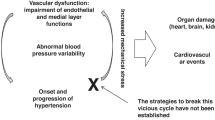Abstract
The resistance vessels play a major role in the pathogenesis of hypertension, for by definition it is they that are responsible for the increased peripheral resistance and thus the increased blood pressure. However, it is still much debated how much the increased resistance is due to altered function or structure of the resistance vessels, and how much to increased levels of activation. The aim of this paper is twofold: first, to review briefly some of the abnormalities of resistance vessels in hypertension, and, second, to discuss the cellular basis for these abnormalities and how this may account for the difficulties in normalising resistance vessel properties with antihypertensive treatment.
Access this chapter
Tax calculation will be finalised at checkout
Purchases are for personal use only
Preview
Unable to display preview. Download preview PDF.
Similar content being viewed by others
References
Aalkjaer C, Johannsen P, Pedersen EB, Rasmussen A, Mulvany MJ (1984) Characteristics of resistance vessels in preeclampsia and normotensive pregnancy. J Hypertens 2 (S3): 183–185
Aalkjaer C, Pedersen EB, Danielsen H, Fjeldborg O, Jespersen B, Kjaer T, Srensen SS, Mulvany MJ (1986) Morphological and functional characteristics of isolated resistance vessels in advanced uraemia. Clin Sci 71: 657–663
Aalkjaer C, Heagerty AM, Petersen KK, Swales JD, Mulvany MJ (1987) Evidence for increased media thickness, increased neuronal amine uptake, and depressed excitation-contraction coupling in isolated resistance vessels from essential hypertensives. Circ Res 61: 181–186
Baumbach GL, Heistad DD (1988) Cerebral circulation in chronic arterial hypertension. Hypertension 12: 89–95
Bohlen HG (1986) Localization of vascular resistance changes during hypertension. Hypertension 8: 181–183
Davis MJ, Ferrer PN, Gore RW (1986) Vascular anatomy and hydrostatic pressure profile in the hamster cheek pouch. Am J Physiol 250: H291–H303
Doyle AE, Fraser JRE (1961) Vascular reactivity in hypertension. Circ Res IX: 755–761
Duff RS (1956) Adrenaline sensitivity of peripheral blood vessels in human hypertension. Br Heart J 19: 45–52
Esler M, Jennings G, Korner P, Willett I, Dudley F, Hasking G, Anderson W, Lambert G (1988) Assessment of human sympathetic nervous system activity from measurements of norepinephrine turnover. Hypertension 11: 3–20
Folkow B (1956) Structural myogenic, humoral and nervous factors controlling peripheral resistance. In: Harington M (ed) Hypotensive drugs. Pergamon, London, pp 163–174
Folkow B (1982) Physiological aspects of primary hypertension. Physiol Rev 62: 347–504
Hutchins PM, Darnell AE (1974) Observation of a decreased number of small arterioles in spontaneously hypertensive rats. Circ Res 34 /35: I161–1165
Korsgaard N, Mulvany MJ (1988) Cellular hypertrophy in mesenteric resistance vessels from renal hypertensive rats. Hypertension 12: 162–167
Korsgaard N, Christensen J, Mulvany J (1991) Basic Res Cardiol
Lund-Johansen P (1983) Haemodynamics in early essential hypertension — still an area of controversy. J Hypertens 1: 209–213
Mulvany MJ (1987a) Vascular structure and smooth muscle contractility in experimental hypertension. J Cardiovasc Pharmacol 10 [Suppl 6]: s79–s85
Mulvany MJ (1987b) The Fourth Sir George Pickering Memorial Lecture. The structure of the resistance vasculature in essential hypertension. J Hypertens 5: 129–136
Mulvany MJ (1988) Résistance vessel structure and function in the etiology of hypertension studied in F2-generation hypertensive-normotensive rats. J Hypertens 6: 655–663
Mulvany MJ, Aalkjaer C (1990) Structure and function of small arteries. Physiol Rev 70: 921–961
Mulvany MJ, Halpern W (1977) Contractile properties of small arterial resistance vessels in spontaneously hypertensive and normotensive rats. Circ Res 41: 19–26
Mulvany MJ, Nyborg NCB (1980) An increased calcium sensitivity of mesenteric resistance vessels in young and adult spontaneously hypertensive rats. Br J
Mulvany MJ, Hansen PK, Aalkjaer C (1978) Direct evidence that the greater contractility of resistance vessels in spontaneously hypertensive rats is associated with a narrowed lumen, a thickened media, and an increased number of smooth muscle cell layers. Circ Res 43: 854–864
Mulvany MJ, Aalkjaer C, Christensen J (1980) Changes in noradrenaline sensitivity and morphology of arterial resistance vessels during development of high blood pressure in spontaneously hypertensive rats. Hypertension 2: 664–671
Mulvany MJ, Nilsson H, Nyborg N, Mikkelsen E (1982) Are isolated femoral resistance vessels or tail arteries good models for the hindquarter vasculature of spontaneously hypertensive rats. Acta Physiol Scand 116: 275–283
Mulvany MJ, Baandrup U, Gundersen HJG (1985) Evidence for hyperplasia in mesenteric resistance vessels of spontaneously hypertensive rats using a 3-dimensional disector. Circ Res 57: 794–800
Owens GK, Schwartz SM, McCanna M (1988) Evaluation of medial hypertrophy in resistance vessels of spontaneously hypertensive rats. Hypertension 11:198–207 Pharmacol 71: 585–596
Schmid-Schonbein GW, Firestone G, Zweifach BW (1986) Network anatomy of arteries feeding the spinotrapezius muscle in normotensive and hypertensive rats. Blood Vessels 23: 34–49
Schulte KL, Braun J, Meyer-Sabellek W, Wegscheider K, Gotzen R, Distler A (1988) Functional versus structural changes of forearm vascular resistance in hypertension. Hypertension 11: 320–325
Short D (1966) Morphology of the intestinal arterioles in chronic human hypertension. Br Heart J 28: 184
Whall CW, Myers MM, Halpern W (1980) Norepinephrine sensitivity, tension development and neuronal uptake in resistance arteries from spontaneously hypertensive and normotensive rats. Blood Vessels 17: 1–15
Author information
Authors and Affiliations
Editor information
Editors and Affiliations
Rights and permissions
Copyright information
© 1991 Springer-Verlag Berlin • Heidelberg
About this paper
Cite this paper
Mulvany, M.J. (1991). Structure and Function of Resistance Vessels in Hypertension. In: Bruschi, G., Borghetti, A. (eds) Cellular Aspects of Hypertension. Springer, Berlin, Heidelberg. https://doi.org/10.1007/978-3-662-00983-3_1
Download citation
DOI: https://doi.org/10.1007/978-3-662-00983-3_1
Publisher Name: Springer, Berlin, Heidelberg
Print ISBN: 978-3-662-00985-7
Online ISBN: 978-3-662-00983-3
eBook Packages: Springer Book Archive




